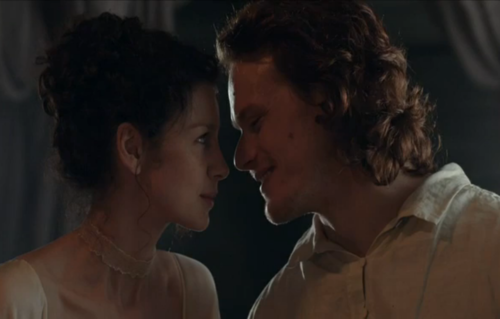
Claire and Jamie bonded over some romantic wedding night pillow talk that fans didn’t see when the first season of Outlander originally aired. Here are some of those deleted scenes. Enjoy!
The deeply grateful,
Outlander Anatomist

Human Anatomy taught through the lens of the Outlander books by Diana Gabaldon and the Starz television series

Claire and Jamie bonded over some romantic wedding night pillow talk that fans didn’t see when the first season of Outlander originally aired. Here are some of those deleted scenes. Enjoy!
The deeply grateful,
Outlander Anatomist
Happy Valentine’s Day!
Confession time: I have wanted to do a lesson on the anatomy of a kiss for a very long time. Today is that day! Welcome to Anatomy Lesson #14: The Lips (and a little tongue too).
Now, you may think there is little anatomy of the lips but there is so much info and complexity that we’ll be lucky to cover it in a single lesson!
I need models for our lesson and who better than Claire getting her first kiss (Starz episode 101, Sassenach). NO, not this kiss!! Claire usually has to urge Frank but she seems to like this kiss just fine and I’m betting there is a group of folks out there that give two thumbs for any face time with Frank.
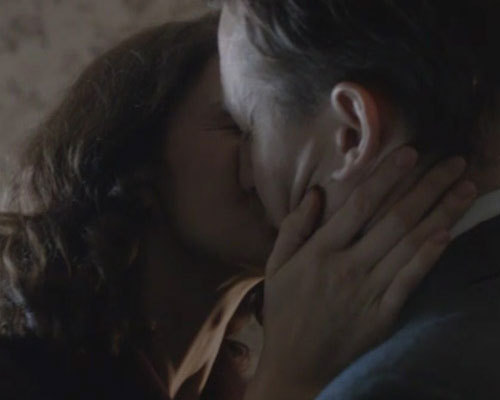
Alrightie then, how about this kiss (Starz episode 104, The Gathering)? NO, again? Geez, some folks are so hard to please!
Clearly Claire is not pleased with this kiss. Dougal’s efforts garner him a kick in the stones, a sharp slap and a wallop over the head with a stool! Dougal, best get ye gone man before you end up “paying a greater price!”
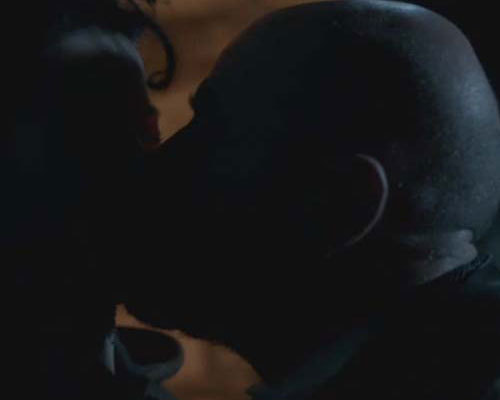
Ok, how about this one? Better? Ha! Getting down to business, Jamie and Claire seal the wedding vows with their first kiss (Starz episode 107, The Wedding). In Outlander book, Herself records the moment:
“More mumbling from the priest and Jamie bent to kiss me. It was clear that he intended only a brief and ceremonial touching of lips, but his mouth was soft and warm and I moved instinctively toward him. I was vaguely conscious of noises, Scottish whoops of enthusiasm and encouragement from the spectators,but really noticed nothing beyond the enfolding warm solidness. Sanctuary.”
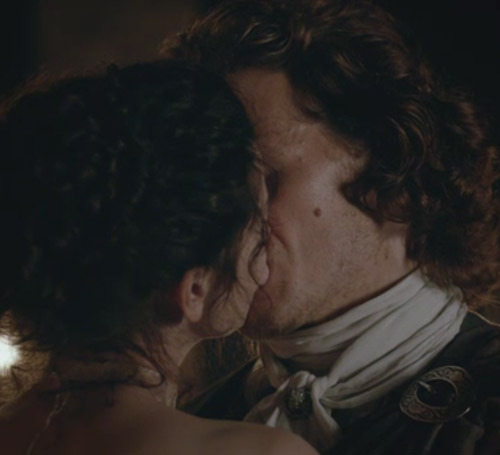
Whoa, Prof! This wedding kiss lasts waaay longer than one brief frame! How about some time lapse photography? OK, students, not to dwell on the point, but here’s Claire as she accepts Jamie’s kiss.
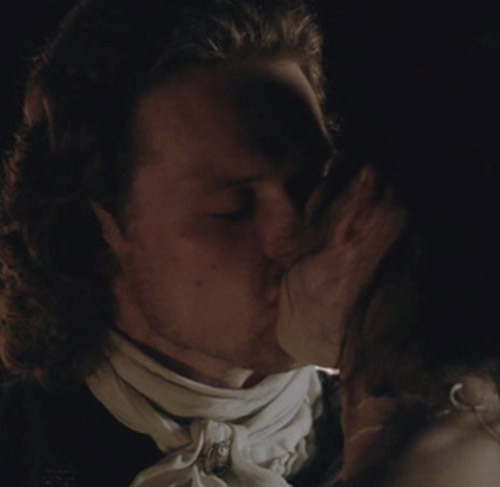
A wee release of the lips and more kiss! Aye, she gives as good as she gets.

More lip action; she really leans into it. Good lass!
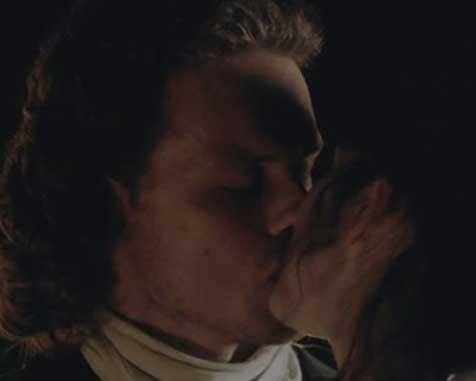
Finally, at the end of the lengthy lip-lock, Claire is on her tippy-toes panting for more. No ceremonial peck here. Well, when she kisses him like that maybe she isna so sorry to be marrying him after all.
Gasp! Mayhap we all best come up for a wee gulp of air!
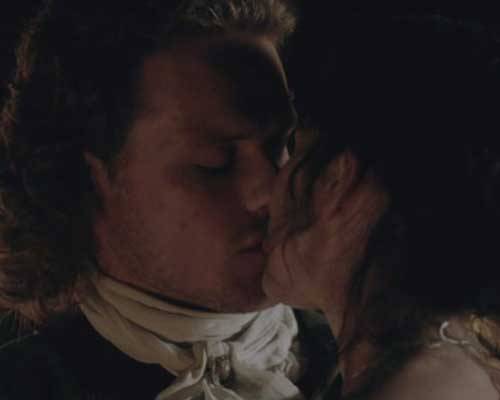
Can I ask you a question? “Did you like it?” He he – Jamie did!
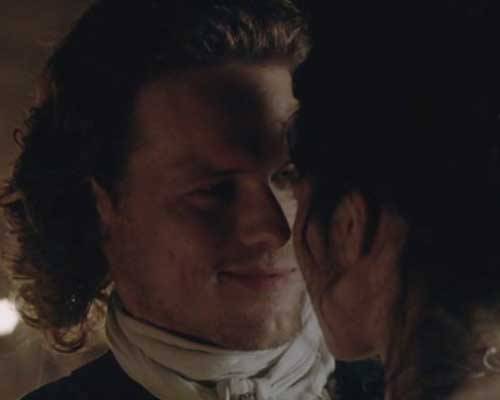
Topography of Lips: Now, on with the anatomy lesson! First, let’s begin with topographical (surface) anatomy of the lips. The lips are the part of the face surrounding the oral fissure, the external opening to the oral cavity (Image A, black arrow).
In anatomy, the upper lip (black bracket) extends from nasal septum all the way inside to the web of tissue near the upper gums. Similarly, the lower lip (red bracket) extends from the groove of chin (red arrow) inside to the web of tissue near the lower gums.
Lips are soft, pliable and mobile and almost prehensile in their movements. Consider that lips are active in biting, chewing, drinking, licking, swallowing, speaking, singing, screaming, sucking, crying, humming, etc. Wow, not too many areas of the body can lay claim to such a vast range of services! And, lastly, the lips are a tactile sensory organ and thus classified as an erogenous zone.
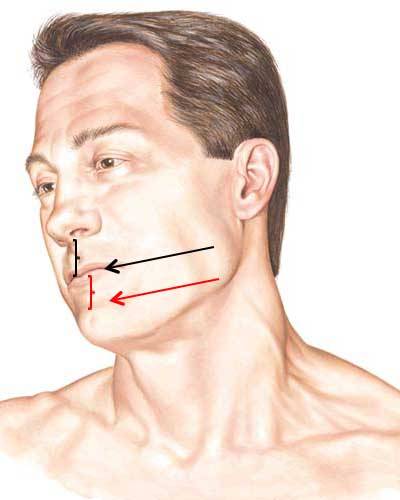
Image A
Image B shows upper frenulum and lower frenulum, webs of tissue that mark the
internal terminus of upper and lower lips. Frenula (pl.) help anchor lips
to gums.
Try this: Grasp your upper lip and lift locate the upper frenulum. Repeat with the lower lip.
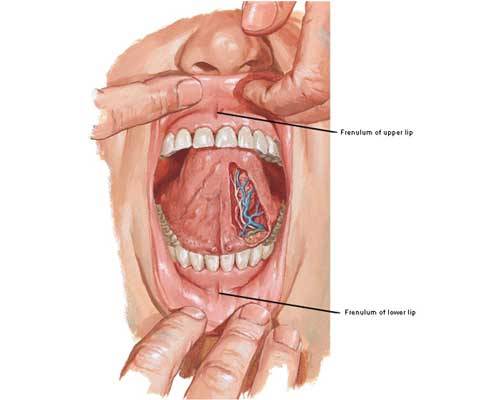
Image B
Vermillion Border: The vermillion border is the margin where facial skin meets upper and lower lips (Image C, black arrows) – the interface where lip liner is applied.
Vermillion Zones: In anatomy, the areas commonly called upper and lower lips are vermillion zones (Image C, black brackets) – the areas where lipstick is applied.
From vermillion zone to oral cavity, lips transition from thin, dry hairless skin to wet mucosa (blue arrows).
Try This: Look in a mirror and identify vermillion border and vermillion zones. Next, pull down your lower lip and find where the skin of the vermillion zone turns into wet mucosa of the inner lip. Got it? Good!
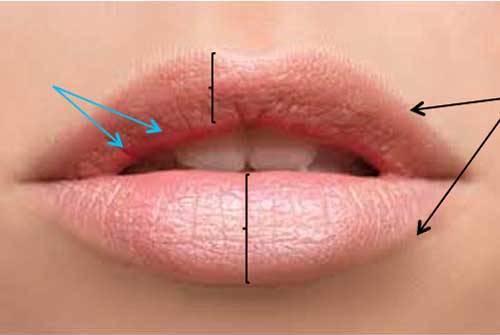
Image C
More Lip Structures (Image D):
Try this: Return to the mirror to locate these features of your own lips or,
better yet, use a partner!
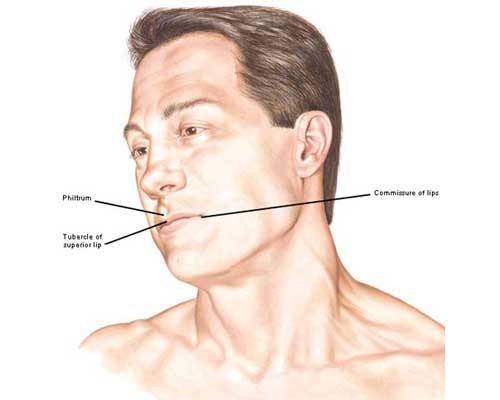
Image D
Always fun to throw in a wee bit of comparative anatomy…in mammals such
as the dog, the philtrum is more extensive, a midline cleft extending from nose through upper lip (Image E – red arrows) that may act as a channel to direct dissolved odorants towards the nasal septum.
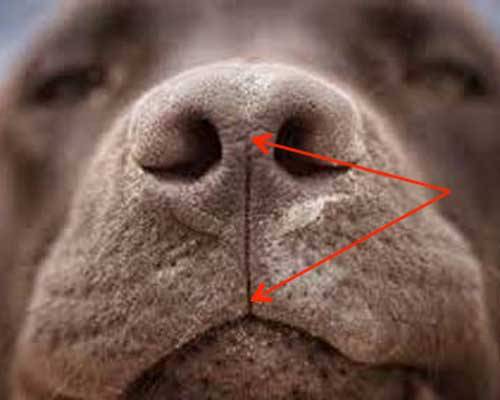
Image E
Cupid’s Bow: The vermillion border of our lower lip is an even line, but not so with the border of the upper lip which bears twin peaks, the so-called Cupid’s bow (Image F – red line) in honor of the weapon born by Cupid, Roman god of erotic love. And, the peaks of the bow coincide with philtral pillars (black arrows). The more prominent the peaks of Cupid’s bow, the more obvious are the philtral pillars.
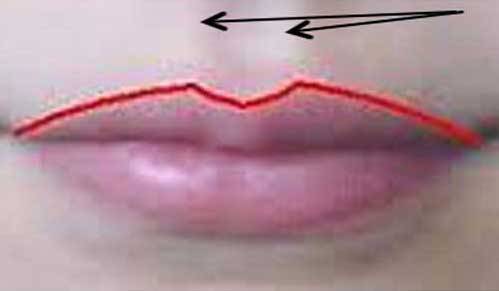
Photo F
No surprise here, but Jamie’s upper lip demonstrates a prime and manly example of Cupid’s bow and its associated philtrum (Starz episode 102, Castle Leoch) but I wager you already ken this. Wink, wink. His bow is well-defined (mmphm) and his upper and lower lips are picture perfect. Studies show that lip size in men is linked to sexual appeal. Subjects in these studies preferred men with masculine lips, neither too large nor too small. Sound like anyone you favor?
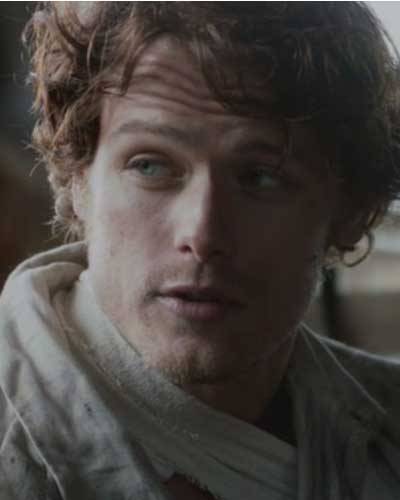
Starz Claire has absolutely beautiful lips that are full, expressive and verra feminine!
They define her face to a large extent and along with her eyes were features I
noticed first (Starz episode 109, The Reckoning). Again, psychology studies have
shown that the larger a woman’s eyes and the fuller her lips, the more desirable and feminine she was perceived by participants of these studies. Lipstick is thought to enhance this underlying perception.
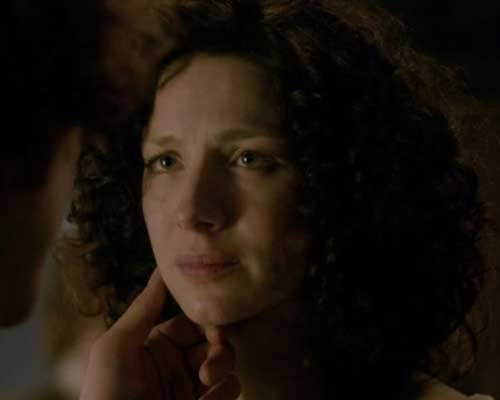
Microscopic Anatomy of Lip: Let’s turn from surface anatomy to the lip as seen in a microscope. Microscopic anatomy is AKA histology (Greek meaning tissue knowledge). Considerable technology is required to prepare tissues for microscopy: samples are imbued with paraffin (sometimes plastic), sliced very thin, picked up on glass slides and stained before examination. How thin is the slice? Well, it would be roughly 6 µm (.006 mm or .00023 in) – thin enough for light to pass through the slice.
Image G is a tissue section of lip as view with a microscope (Image G). It takes
some skill to recognize subtle differences, but the top box surrounds a patch
of facial skin with hair follicles, sweat and sebaceous glands (Anatomy Lesson
#5 and Anatomy Lesson #6); the left box encloses the vermillion zone of thin
skin sans hair and glands; the bottom box surrounds a patch of wet mucosa
(living cells throughout the surface layer). Look closely: the black arrow
points to dovetails (interdigitations) between the dark red thin skin and the deeper
pink-blue dermis. Let’s take a closer look:
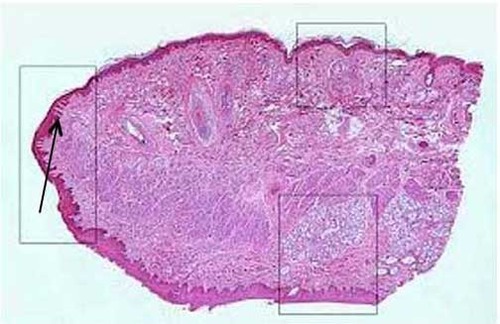
Photo G
Hey, students, wake up! Stay with me now – I can see you nodding off! Here, this might help (Starz episode 102, Castle Leoch). Oh, weel, I see that got your attention. Talk about lips doing their job and giving us a full wattage smile!
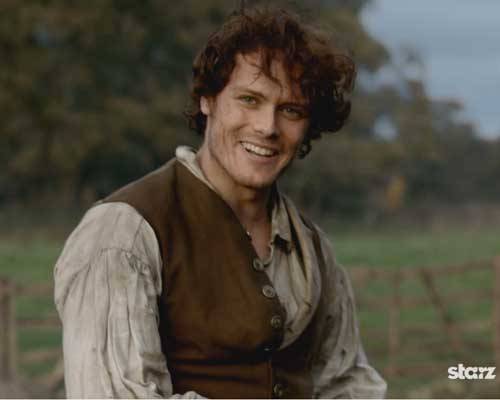
Photo H is a much higher magnification of the dovetail region indicated by the arrow in Photo G. See the odd pink oval structure that resembles shredded wheat or
venetian blinds (Photo H-black arrow)? This is a special sensory body first identified by Georg Meissner, a German anatomist and physiologist (1829-1905). These structures, named Meissner’s corpuscles are excited by light touch. The dermis of
erogenous zones, such as the lips, contains higher concentrations of Meissner’s
corpuscles than non-erogenous regions. When excited by light touch, the nerve
endings fire and information is transmitted along nerves to the brain.
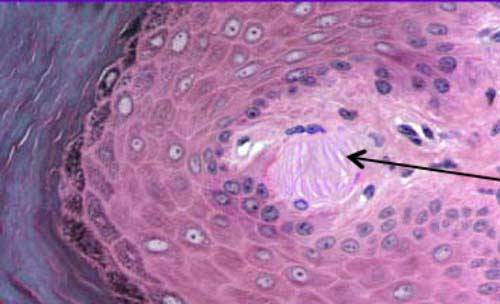
Photo H
Photo I is an artist’s rendition of a Meissner’s corpuscle. The lavender and black region is overlying thin skin; the gold and black structure is the corpuscle. Ergo, increased numbers of these touch-sensitive structures explains the basis of the so-called erogenous zones of the body.
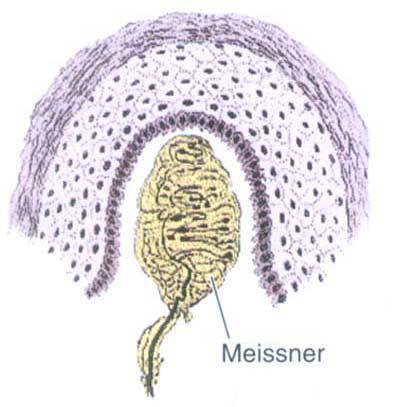
Photo I
Break time for practical
application of our knowledge about the lips: From Outlander, Herself quotes the Latin poet, Catullus:
“Then let amorous kisses
dwell
On our lips, begin and
tell
A Thousand and a Hundred
score
A Hundred, and a Thousand
more.”
Well, Jamie and Claire dinna disappoint. There are many amorous kisses shared by these two in Starz episodes 107 and 108. I was actually surprised by the frequency as I worked on this post. Gah! Messed with my sleep patterns!
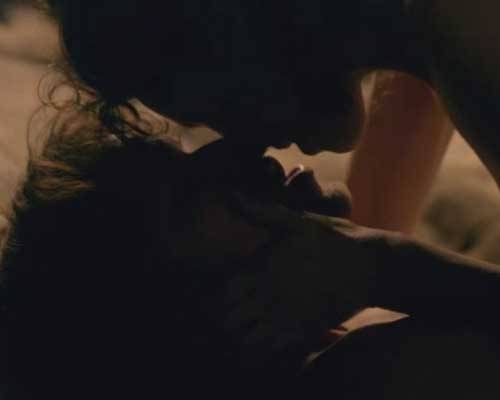
Now let’s move to gross anatomy of the lips. Do you recall from Anatomy Lesson #11 the name of the muscle surrounding the oral fissure? If you said orbicularis oris, you get 100 points! For years, anatomists taught that orbicularis oris was a circular, sphincter-like muscle that contracted like a camera diaphragm to close the oral fissure (Photo J). Well, recent studies have proven this is not the case.
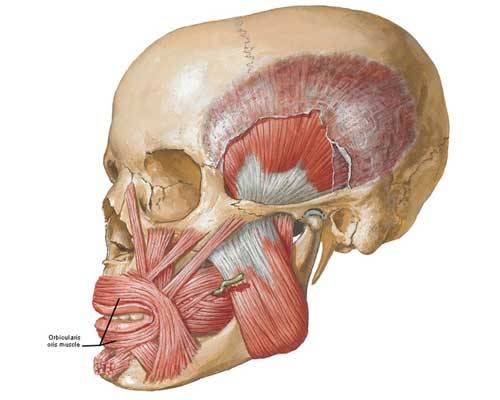
Photo J
Orbicularis oris is composed of four interlacing quadrants of muscle (Photo K – right side only): upper left, upper right, lower left, lower right. Further, each quadrant is divided into two parts: fibers of the vermillion zone form pars marginalis (Latin meaning marginal part) and fibers outside the vermillion border form pars
peripheralis (peripheral part). Doing simple math, this means our oral fissure is surrounded by eight interactive layers of orbicularis oris. This arrangement lends major control over shape so orbicularis oris is proficient at closing and puckering the lips.
Also, notice the mass labeled modiolus (Photo K)? This is a paired fibromuscular node just inside the commissures of each lip.
Try this: slip a clean thumb inside a corner of your mouth about 0.5 in (1.25 cm); close your index finger against the thumb. You should feel a thickening; this is the modiolus. At least seven facial muscles connect to or pass through each modiolus (one on each side) making it extremely important to facial symmetry. While performing surgery of the lip area, reconstructive surgeons strive to symmetrically align the modioli (pl.); once these are secured, associated facial muscles of each side are more likely to balance. Notice that orbicularis oris fibers attach to the modiolus.
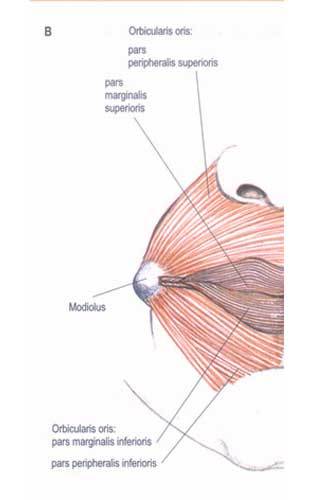
Photo K
The following line drawing (Photo L) shows how the upper lip changes shape during contraction of orbicularis oris. Imagine a midline vertical slice (midsagittal plane) through the upper lip, then view it from the side; the stick drawing is a simple rendering of that slice. The pink line shows the lip shape at rest; the blue line shows the lip flattened during a pucker. The shape-shifting is due to contraction of orbicularis oris.
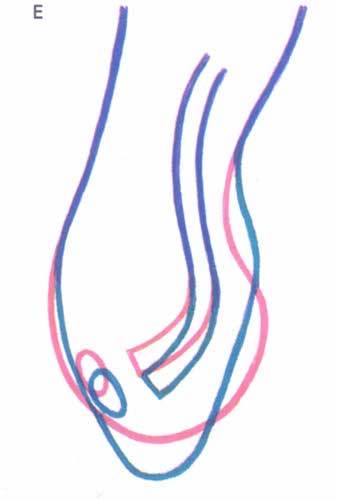
Photo L
Here’s a verra good example of lip puckering by Jamie’s orbicularis oris as he plants a lovely one on Claire’s lips. Good job, lad! He’s a terrific anatomical model as I keep saying (over and over and over). Ha! Well, it’s true!
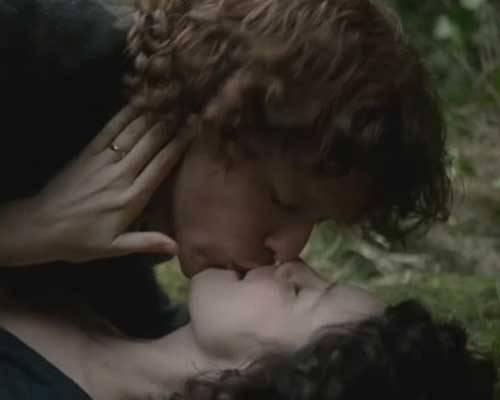
Time for another interlude: how about this image from Starz episode 107, The Wedding at the end of the first amorous kiss between Jamie and Claire? Oh, Jamie, your lip looks a wee bit swollen. Did you get thumped by a horse? Those fillies can be
dangerous! Whinny!

And yet another drop-dead wonderful kiss between our hero and heroine! The next quote doesn’t exactly fit wi’ the image (Start episode 107, The Wedding) but I’m betting ye can suffer through it. Herself writes in Outlander book:
“He leaned down and gently fitted his mouth over mine. I had kissed my share of men…Jamie, though, was something different. His extreme gentleness was in no way tentative; rather it was a promise of power known and held in leash; a challenge and a provocation the more remarkable for its lack of demand. I am yours, it said. And if you will have me, then…I would, and my mouth opened beneath his…”
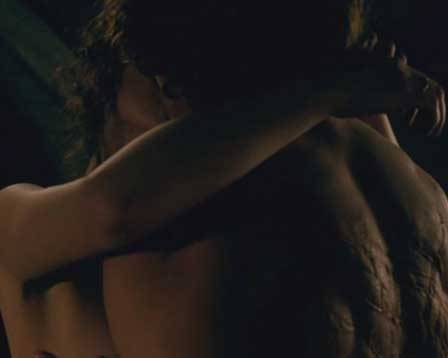
Hey, yoo hoo, back to anatomy. I think I lost ye again, ha ha! It’s OK, I lost it myself…So, you may recall that several muscles of facial expression insert into orbicularis oris (Anatomy Lesson #11 and Anatomy Lesson #13) adding their tug on the lips. LLSAN, levator labii superioris and zygomaticus minor act as retractors to lift and curl the upper lip; platysma and depressor labii inferioris pull down and curl the lower lip
(Photo M). The left side of the drawing (on your right) shows the pull of the three elevator and two depressor muscles acting as retractors on orbicularis oris.
All of this detail reveals that our lips have a complex muscular framework, an arrangement lending impressive control over the lips and how they might engage in kissing: pucker, no pucker, curl, no curl, suction to produce a smack. Aye, if the lips are slightly curled and mild suction applied, the kiss produces an audible smacking sound. Re-watch (for the umpteenth time) Starz episode 107, The Wedding, and listen to the end of the wedding kiss; you hear a soft smack. Verra, erm, satisfying! Now ye know how that happens.
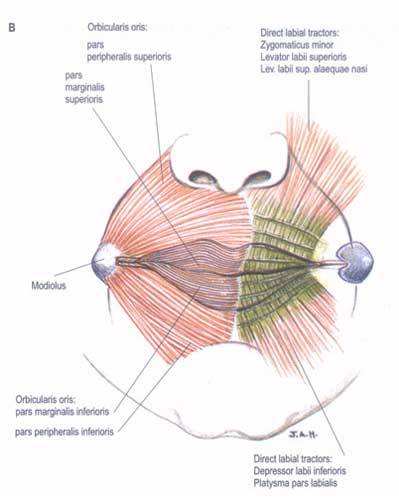
Photo M
Many would argue that a kiss will be neither complete nor completely satisfying without a wee bit of tongue. I dinna have space to cover all tongue anatomy which is complex and lengthy. But a brief keek will suffice. The tongue core is very nearly all muscle; it participates in swallowing, taste, and speech. Its free surfaces are covered
with wet mucosa similar to that of the inner lips. Its top and sides are embellished with wee bumps, the papillae, some of which house taste buds. Photo N is an image of the tongue taken with a scanning electron microscope (SEM – Anatomy Lesson #5 and Anatomy Lesson #6), an instrument that greatly magnifies an object because it illuminates using an electron beam rather than light rays. Papillae on the top of the tongue are very apparent (red arrows). Check out your own papillae in a mirror; they come in 3 or 4 different shapes. Your taste buds are microscopic so ye cannot see them.
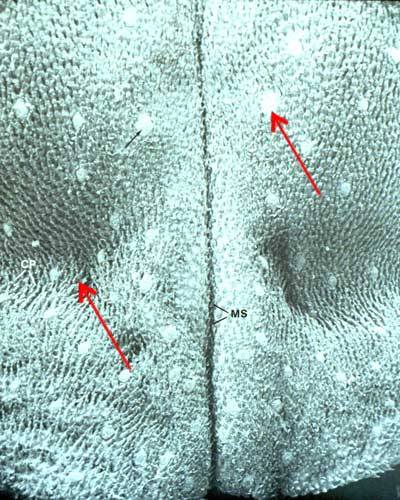
Photo N
For the tongue to join in a kiss, its muscles must activate. Hard to believe but the tongue contains nine different muscles: four paired and one unpaired (Photo O)! Paired muscles are extrinsic meaning they arise from surfaces outside the tongue but end within it. The unpaired muscle, consisting of four layers, is intrinsic meaning the layers arise from and end within the tongue itself.
But, perhaps the four layers of intrinsic muscle are most appreciated in kissing. They arise from various parts of the tongue and blend with the extrinsic muscles. Acting alone or together the four layers curl, shorten, dome, narrow, elongate, widen or fatten the tongue. Whew, that’s quite a list! Intrinsic muscles give the tongue precise and highly variable mobility for speech, swallowing and (although not listed anatomy texts) for kissing! So, consider this is why a kiss with tongue can be so remarkably creative. Try it out! Ye have my permission.
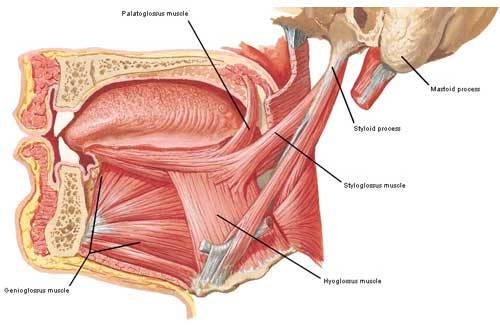
Photo O
This last image (Starz, episode 107, The Wedding) is dark, but here Jamie serves once again as our anatomical model; the camera clearly loves him! This is just after Claire wraps him in a lover’s shroud of his own plaid. Oh, aye, his tongue is involved in this kiss. If ye canna see it here, go watch the episode again. OK, ye can all get up off the floor now!
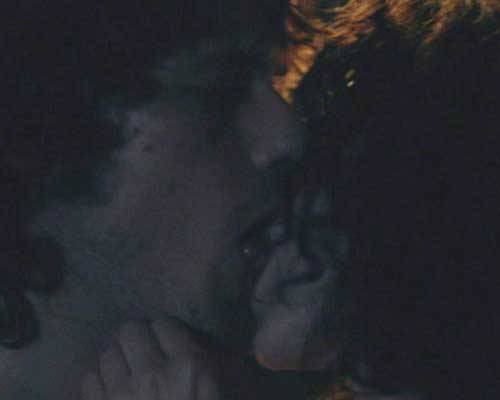
So kisses involve lips and mayhap tongue and given the number of muscles involved
humans are granted considerable creative license in their use. Hope ye get to use yours on this beloved day and that ye all enjoyed learning about those busy lips and tongues and the anatomy of a kiss.
And if ye dinna have a partner today, then remember that your body contain trillions of cells each whispering “Tha gaol agam ort!” Gaelic for “I love you!” If our cells didna care, we probably wouldn’t exist.
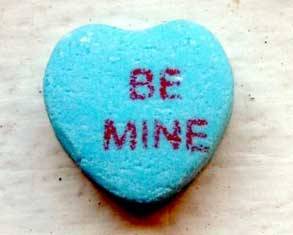
Let’s end the lesson with a wonderful quote from Les Miserables by Victor Hugo (1802–1885):
“How did it happen that their lips came together?
How does it happen that birds sing, that snow melts,
that the rose unfolds, that the dawn whitens behind the stark shapes of trees on the quivering summit of the hill?
A kiss, and all was said.”
And for those who are new to my blog, a wee note of explanation: I follow the convention of using Outlander character’s names rather than actor’s names. This gives the cast at least one degree of separation and a wee bit of respect as I
dissect their bodies with words! I hope ye all understand!
The deeply grateful,
Outlander Anatomist
Follow me on Facebook and Twitter!
Photo Credits: Starz, Gray’s Anatomy 39th ed., Netter’s Atlas of Human Anatomy, 4th ed., Clinically Oriented Anatomy, 5th ed., Hollingshead’s
Textbook of Anatomy, www.emedicine.medscape.com, www.elementsofmorphology.nih.gov, www.britannica.com, www.instruction.cvhs.okstate.edu, www.siumed.edu, www.Wikipedia.org, www.iup.ui.edu, www.bio.rutgers.edu, www.wallpapers.brotherssoft.com
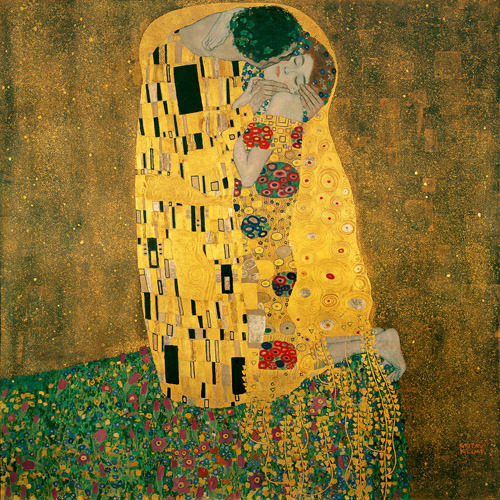
Don’t you just love Gustav Klimt’s painting of “The Kiss?” Please join me tomorrow on Valentine’s Day for a special lesson: The Anatomy of a Kiss!
The deeply grateful,
Outlander Anatomist